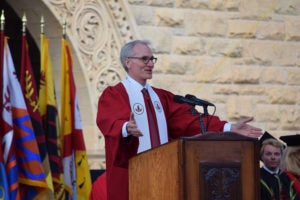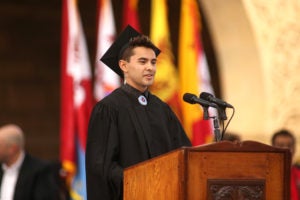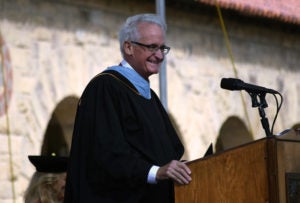Explore with curiosity and enthusiasm, Stanford president urges

Stanford President Marc Tessier-Lavigne encouraged new undergraduate students on Wednesday, Sept. 18, to emulate Leonardo da Vinci’s relentless curiosity, individuality, ability to work well with others and persistent quest to continually improve his work.
Speaking at the 129th Opening Convocation Ceremony in the Main Quad, Tessier-Lavigne said many people know Leonardo’s artistic masterpieces – Mona Lisa and The Last Supper – but may know less about the achievements that transcend his paintings.
“He was an inventor, a scientist, an engineer and a scholar of literature, anatomy and architecture,” Tessier-Lavigne said. “He was always exploring, always trying to learn more about a sweeping list of topics. His interests ranged from determining the different techniques needed to paint reflected light as opposed to direct light, to understanding the mechanics of a woodpecker’s tongue. Leonardo’s boundless curiosity across disciplines – and his approach to combining the arts and sciences in his work – made him what we consider today to be the quintessential Renaissance Man.”
Despite his genius, Leonardo, who lived in Italy during the Renaissance in the late 15th and early 16th centuries, also experienced disappointments, just like everyone, but he wasn’t deterred when he fell short, Tessier-Lavigne said.
Tessier-Lavigne assured new students that if and when they hit rough patches, the Stanford community – including advisors, professors, coaches and resident fellows – is ready to help.
“In fact our entire university is deeply committed to your well-being,” Tessier-Lavigne said. “Although I believe each and every one of you is capable of producing masterpieces in your lives, and you should know you are capable, you should not expect them to come right away. But you can expect to start envisioning them here – and everyone here is excited to help you get started.”
Tessier-Lavigne was one of several speakers who welcomed new students and their families and friends to campus during the ceremony, which inaugurates the academic year. The hourlong event also featured senior Will Paisley; Richard Shaw, dean of admission and financial aid; and Harry Elam, senior vice provost for education.
Valued community

Will Paisley, who introduced himself in the Navajo language as a “Two-Spirit Navajo and Blackfeet,” said the value he holds dearest at Stanford is community, which he found first through the Stanford Native Immersion Program, a retreat for new Native American students. That program gave him the confidence to “integrate seamlessly” into the Stanford community, he said.
“Since then I have found many other orbits and communities that I now belong to, and I can’t begin to describe how enriching it’s been,” he said. “My greatest joy at Stanford has been building relationships with peers and mentors who inspire and fuel my passions and objectives. Around me, I have people who support me wherever needed and who continuously encourage me to be the best version of myself.”
Paisley said opportunities at Stanford have been the key to his personal growth, including serving as co-chair of the Stanford American Indian Organization, and studying in Santiago, Chile, through the university’s Bing Overseas Studies Program. Paisley, who is majoring in sociology and Native American studies, said he is writing an honors thesis on entrepreneurial Native American fashion that he hopes will help others understand the burgeoning contributions its rich, diverse and ancient cultures continue to make today.
“At Stanford, you can find mentors, friends and family and most importantly, yourself,” he said. “I feel incredibly blessed to attend this institution and, today, I am excited and happy for you, because it’s now your turn to find your own blessings and create your own community.”
Grow and thrive
In his address, Shaw said the incoming community of undergraduates includes 1,702 first-year students in the Class of 2023 and 20 transfer students.

Shaw said the new students, whom he described as “beautifully diverse,” represent 48 states – all save Mississippi and North Dakota – and 77 countries. More than 11 percent of the new students are citizens of other countries.
“Nearly 19 percent of you are the among the first in your families to attend a four-year university,” he said. “Nine of you are military veterans – and we salute you.”
Noting that today’s young people have grown up in an era of rapid-fire and abbreviated digital communication, Shaw shared one “heartfelt request” with the new students to occasionally put their mobile devices away and take the time to pause, slow down and engage fully at Stanford, a place full of life, learning and endless possibilities.
“We look forward to seeing you grow and thrive,” Shaw said.
A great adventure
In his welcome address, Elam told the new students that they will find a unique brand of liberal education at Stanford.
“Liberal education at Stanford purposefully embraces and fully immerses you in the humanities and arts, as well as the social sciences and engineering, because we are concerned about and invested in your whole being, your complete self,” he said.
Looking out at the rapt audience, Elam said he hopes students will come to see and know for themselves that nothing is impossible at Stanford, because it is a university that “rejoices in and cultivates the leavening spirit of invention,” and has a unique culture that “embraces the “uncommon, uncertain routes, and the less predictable trail.”
He said Stanford offers many pathways to becoming part of its educational community.
“We trust you will find your way, and also find your people,” Elam said. “Rest assured, Stanford will change you. And in turn, you will change all of us. The great adventure that is your undergraduate experience begins here today. Welcome to Stanford.”
